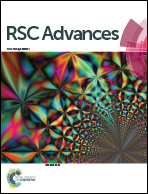BiOI hierarchical nanoflowers as novel robust peroxidase mimetics for colorimetric detection of H2O2†
Abstract
In this paper, BiOI hierarchical nanoflowers (BiOI-F) were developed as a highly efficient biomimetic catalyst for the first time and used to detect H2O2. BiOI-F could be synthesized through a facile one-pot coprecipitation method, and some other BiOI samples with different morphologies were also prepared as controls. The crystal growth and morphology transition mechanism of BiOI samples was proposed, which were responsible for the distinct peroxidase-like activities. BiOI-F was demonstrated to exhibit the best intrinsic peroxidase-like activity compared to other BiOI samples due to its negative potential, large BET specific surface area, the exposed (001) facets, and the oxygen vacancies in the crystal lattice, which could efficiently catalyze the oxidation of 3,3,5,5-tetramethylbenzidine (TMB) in the presence of H2O2 to produce a blue oxide. In view of the excellent peroxidase mimetic catalytic activity of BiOI-F, a sensitive and convenient novel platform for colorimetric detection of H2O2 was successfully established, and the detection limit of H2O2 was as low as 0.05 μM. Moreover, the enhanced peroxidase-like activity of BiOI-F was proposed according to the crystal growth mechanism, surface property characterizations and active species trapping tests. In addition, the BiOI-F-based assay system displayed excellent selectivity, practicability, long-term stability, reproducibility, and reusability. This work not only develops a novel, simple and highly sensitive BiOI-F-based visual system for the detection of H2O2, but also provides some new insights into seeking for novel enzyme mimetics with enhanced catalytic activities, which have great prospects in practical applications for H2O2 detection and biomedical analysis.


 Please wait while we load your content...
Please wait while we load your content...